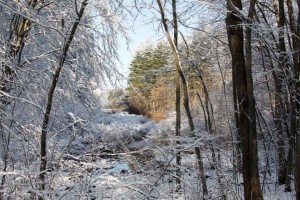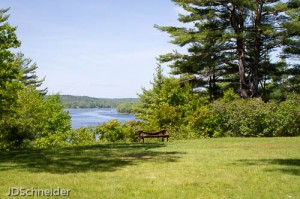Water Closet for August 1, 2014
This mid-July, in north Lynnfield along the Ipswich River the Middleton Council on Aging/Conservation Commission hikers walked a little known path; some places no path at all, in the shade of tall eastern white pines.1 While the same species, these pines aren’t the giants we’d read about that were here before the English, but at three-feet in diameter, some 90 feet or more in the air, they do themselves proud. Before tree cutters, wielding steel axes in the 17th and 18th centuries seeking mast trees for the King’s ships, pines here were twice 3-feet across, some soaring 200-feet. Other species of trees had a chance to get larger then. There are stories and photos of American chestnuts seven feet in diameter and well over 100 feet tall. The Indians’ tools couldn’t cut the big pines, chestnuts, and oaks; there was really no need to. They made serviceable dugout canoes from three-foot diameter pine trunks felled with fire.
Here in the Water Closet we’ve gone on about our pines many times before, especially their roles as dead trunks with bare branches, high platforms for great blue herons’ nests.

The evergreen trees are Eastern White Pines on the edge of Middleton Pond. The snow decorated deciduous trees in the foreground are Red Maples.
Pam Hartman photo
In addition to their year round beauty pines provided colonists with an easily worked wood for ship masts, boats, houses and barns. From colonial times to the late 19th century it was the number one commercial lumber tree in the country. Much was exported.2 White pine is light and relatively strong for its density. One old Closeteer often tells of the Cape style house his father built all of white pine from a grove near the Seabrook, New Hampshire – Salisbury, Massachusetts line. His uncle Bill cut them one winter in the mid-forties. The following fall they were standing again, this time as boards and beams in a fine new home. There are many old houses in our area made mostly of pine, the wood hidden by siding without and plaster within. Their worst times are during hurricanes. The 1938 monster broke and pushed over millions here in the northeast. Yearly we find them snapped off mid-trunk or toppled after severe nor’easters. Those in wet ground have spread-out shallow roots. The roots and clinging soil of fallen trees often rise above the ground. In river and stream valleys the great evergreen sails get some protection from winds.
But it wasn’t the winds and mast loggers that did-in most pines in New England. It was the farmers of the 17th, 18th and 19th centuries who kept the land clear for their livestock and plows. Once cleared the cattle, horses and hogs ate almost everything that grew including seedling trees.
Then in the early 1800s the Industrial Revolution came riding in on rails with a vengeance. “Vengeance” you ask? It came to us from England this time, but not as red coated troops. Our towns became mill cities pouring forth cloth and shoes. Young people from farms flocked to them for jobs. Trains brought in grain from the flatter, deeper soils of the west. Our thin soiled farms here diminished in number. Within a century, by WWII, there were few left. In the mid-19th century the town of Hamilton had 93 working farms;3 there were probably more in Danvers. Now there may be less than twenty in the whole of Essex County. Coal and later oil were imported for fuel. The fields went over to bushes and then to trees. No longer nipped in the bud by cows the latter thrived, so now, except for buildings, parking lots, and lawns there are woods. After a hiatus of perhaps 3000 years the forests have returned to our coastal lands. It was the coastal Indians with their annual fires who kept the land open before hoofed livestock. Our hike on Friday was in 20th and 21st century grown woods protected by man from fire and without cattle, sheep, pigs and horses.
Lynnfield like many other towns, wisely set aside a large watershed where the old hikers enjoyed the high shade along the south side of the river across from North Reading. On passing a pleasant section beside the winding path they happened upon a slight opening in the pine canopy. The ground below was covered with a dense stand of knee to waist high pines. Someone counted the branch whorls on a couple and found each little pine was about a dozen years old. If northeasters down a few more large pines around them, light will pour in and growth will go from an inch or two a year to twelve or more. In a couple hundred years, if Lynnfield continues to maintain its pubic watershed there may be trees the size of those we read about in Indian days. The white pine forests stretching from the Maritimes to Manitoba and south to Ohio and Georgia were then enormous.

The Eastern White Pines seen on the right grace the edge of this Maudsley State Park field on the Merrimack River. Before the English colonists in the 17th century some pines along our rivers were close to 200 feet high. Within a century most had been exported to England for ship masts.
Judy Schneider photo
Dense straight-trunked stands of pine are provided with some protection from storms by higher land and better anchored oaks around them. Let’s hope the increased hurricanes some predict due global warming will leave a few for our descendants to marvel at. “Wow, look at that pine tree it must be 2-meters across and according to my enhanced GPS on a mini-drone it is 45-meters high!” The speaker circa 2120 sent her pocket drone to the top of a large pine for a reading. We are pleased to see she thinks in meters. The British foot we couldn’t shake is finally gone.
Thoughts of a drone taking the fun out of guessing and returning with rulers for a little triangulation makes us old timers who haven’t kept up with high tech a little sad. It probably shouldn’t, the new folks with their remarkable tools have the ability to provide better protection for the habitats of animals, plants, a myriad of organisms unseen. They should certainly do better than those of generations preceding theirs. Future scientists may have personal drones strapped to their backs and computers transplanted within their heads as they fly above tree tops. This thought makes us sad again. It was quiet on our woodland walk. We hope all people will leave phones and drones at home.
A few days after that Friday hike three Stream Teamers paddled on the meandering channel of the Ipswich River just north of the path taken by the hikers. They started at North Reading River Park and ended at the Bostik dam in Middleton, a meandering channel distance of five miles.4 No live pines or other large trees were seen standing in the now bush-flower covered, beaver drowned floodplain. Many submerged and half floating fallen trunks lie in and across the squiggly channel. These were of standing red maples before the beavers returned at the start of the new millennium. Upon rounding endless curves during moments pointing south the paddlers looked up at the high pines so recently walked under. One old paddler tried to imagine them another sixty feet higher, tops 150 feet above the ground. In four more human generations that might be the case. Our descendants may walk among two-meter diameter trunks. We hope they stop now and then and form circles of bodies, arms and clasping hands around them. Stream Team hikers stopped last fall to have the kids in a group ring an old hemlock almost as large as long ago pines. There were eight kids nose to bark with sixteen hands joined. If circlers know the history of the white pine here, they may sense that they, plus their ancestors, have come full circle.
1 Pinus strobus is its scientific name. Some other common names are soft, pumpkin, or Weymouth pine.
2 Pages 3-4. Peattie, Donald Culcross. Trees of Eastern and Central North America. This may be our favorite book on trees. Peattie in lively interesting language tells the natural and social history of each tree.
3 Nason, Elias. Chapter on Hamilton in History of Essex County Massachusetts. 1878.
4 2.5 miles as the cormorant flies when it flies straight point to point – The Bostik dam may be taken down in the next few years. See the Ipswich River Water Association’s summer 2014 issue of The Voice of the River for more information. Spawning fish may return to a river flanked by growing pines.
_______________________________________________________________________
WATER RESOURCE AND CONSERVATION INFORMATION
FOR MIDDLETON, BOXFORD AND TOPSFIELD
| Precipitation Data* for Month of: | April | May | June | July | |
| 30 Year Normal (1981 – 2010) – Inches | 4.53 | 4.06 | 3.95 | 3.89 | |
| 2014 Cent. Watershed Actual – Inches | 2.88 | 2.77 | 2.03 | 10.0 as of 7/28** | |
Ipswich R. Flow Rate(S. Middleton USGS Gage) in Cubic Feet/Second (CFS)
For July 29, 2014 Normal . . . 6.6 CFS Current Rate . . . 93 CFS
*Danvers Water Filtration Plant, Lake Street, Middleton is the source for actual precipitation data thru June. Normalsdata is from the National Climatic Data Center.
**Updated July precipitation data is from MST gage.
THE WATER CLOSET is provided by the Middleton Stream Team: www.middletonstreamteam.org or <MSTMiddletonMA@gmail.com> or (978) 777-4584

